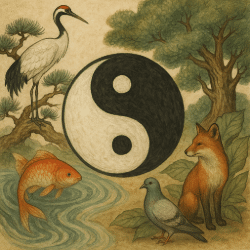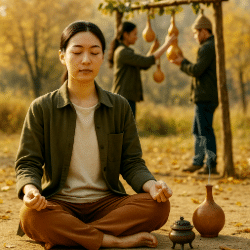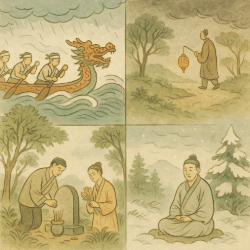Animals in Taoism: Companions in the Way
They move through the forest, sky, and water—not as metaphors, but as teachers. In Taoism, animals are not symbols to interpret but presences to observe. They do not strive, they do not explain. Yet they live in harmony with the Tao.
This article is the home for all our animal-related writings in Taoist life. Here you’ll find quiet studies of deer, turtles, cats, snakes, and more—each a living illustration of Tao’s many faces.
Why Taoism Watches Animals
To a Taoist, the heron’s stillness or the cat’s soft step is not charming—it is instructional.
Animals live without pretense. They follow rhythm and necessity. When they rest, they truly rest. When they act, it is without hesitation. They do not interrupt themselves with abstraction. In this, they resemble the Tao.
“The great Tao flows everywhere… It clothes and feeds all things, yet does not call itself master.”
— Dao De Jing, Chapter 34
Animals follow this naturally. Humans, by contrast, forget—and must relearn.
Not Totems, Not Pets
In Taoism, animals are not worshipped. Nor are they reduced to mascots or decorative myths. They are seen—truly seen.
The way a deer lifts its head, the spiral of a snake, the pause before a crane takes flight—these are teachings in motion. By watching without interference, one can begin to practice without force.
Some Taoists kept animals near for companionship. Others lived alone but observed daily patterns. A cat sleeping on a warm rock. A bird calling once, then falling silent.
Commonly Honored Animals
Here are a few of the animals that recur in Taoist texts, art, and practice—not always for supernatural reasons, but for the way they embody natural harmony.
Deer – The Quiet Wanderer
Gentle, alert, and always aware. The deer is a guide in many Taoist traditions. It moves without sound and rests often. It teaches humility, patience, and knowing when to leave unseen.
📖 Related: Deer in Taoist Mythology – Guardians of Wisdom and Immortality
Turtle – The Immortal Pattern
The turtle carries the cosmos on its back. Its shell mirrors heaven and earth, and its slow pace is a reminder: speed is not mastery. Turtles are linked to long life and deep wisdom.
📖 Related: Taoist Myths of Turtles and Tortoises
Snake – The Coiled Force
Quiet, sudden, and transformational. The snake sheds its skin, and with it, old identity. It lives close to the earth and teaches both danger and rebirth.
📖 Related: Snakes in Taoism – Legends, Practice, and Daily Life
Cat – The Embodied Mystery
The cat is not a Taoist—but it might as well be. Independent, poised, and without unnecessary motion. Its sense of timing and restful presence are admired in many monastic settings.
📖 Related: Guardians of the Tao – Mystical Cats
Fish and Carp – Swimming the Current
The fish lives in the water and feels the current without needing to name it. The carp, especially, represents perseverance, often swimming against the current to reach transformation.
📖 Related: Carp and Koi in Taoism – Symbolism, Rituals, and Geography
Living with Animals in Taoist Daily Practice
For lay practitioners, animals offer more than symbols—they offer invitations.
Walking in the early morning, listening for birds.
Sitting still and letting an animal pass without fear.
Watching without trying to “understand.”
Many Taoist gardens include animals naturally—birds bathing, insects buzzing, frogs humming. The goal is not to dominate nature, but to be still enough that it reappears.
Lessons from Living Encounters
Not all animal teachings come from sacred texts or temple carvings. Some arrive in silence, in alleyways, in quiet moments when attention returns.
Taoist practice values such ordinary revelations. The Tao is not far away—it is on the windowsill, or in a feather drifting past.
Here are two quiet moments where animals taught more than lectures could:
The Pigeon Who Taught Stillness
A pigeon visited the author during chores—not as omen, but as uninvited companion. Its presence became a mirror, showing how to address the needs of natural living.
Where to Go Next
This guide connects to several focused articles that explore animals and Taoist life in detail: that explore animals and Taoist life in detail:
Closing: A Mirror Without Judgment
In the end, animals are not here to serve as signs. They simply live. And in their living, they mirror the Tao. Their silence teaches, their action aligns.
If you wish to study Tao, go to the riverbank or forest path. Do not speak. Wait. The lesson may come, if you are still enough to see.
Frequently Asked Questions
What animals are important in Taoism?
Taoist tradition honors animals like deer, turtles, snakes, cats, and fish for their natural behaviors that embody aspects of the Tao. Each reflects qualities like longevity, stillness, transformation, or effortless action.
Are animals worshipped in Taoism?
No, animals are not worshipped in Taoism. They are observed with deep respect for how they live in harmony with nature, serving as quiet teachers rather than divine figures.
What does a cat symbolize in Taoist thought?
The cat is often admired in Taoist writing for its balance, independence, and ability to rest or act without wasted energy—qualities aligned with the principle of wu wei (non-forcing).



